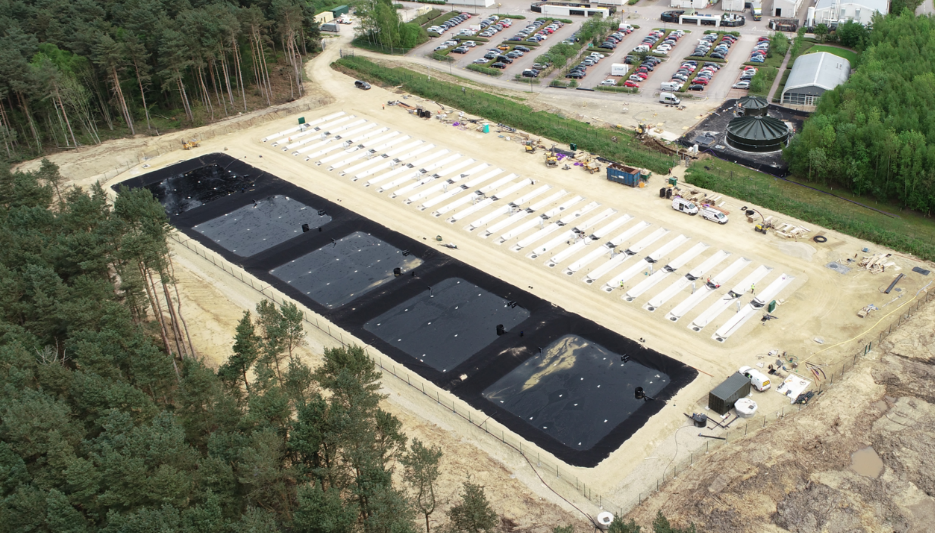The bigger the better
4 Mar 2019 by Evoluted New Media
A UK-wide prohibition on the use of plastic microbeads in some cosmetic and personal care products came into effect in 2018, but what fundamental lessons can we learn from this high-profile case? Dr Rachael Benstead tell us that when it comes to testing aquatic environment, bigger is better…
Figures from The Department for the Environment, Food and Rural Affairs (DEFRA) suggest that an estimated 680 tonnes of microbeads are used in cosmetic products every year.
These tiny pieces of plastic, used for exfoliation in rinse-off products such as toothpastes, face scrubs and shower gels, inevitably end up contaminating the environment. In fact, in the course of a single shower approximately 100,000 plastic particles can enter the sewage system.
Yet it's not the mass, nor the amount of these particles that is most concerning, but the size of these plastic pieces. With particle sizes varying from 10 micrometers up to 1 millimetre, microbeads are the same size as much of the organic material consumed by invertebrates. This means they can be easily be ingested by such organisms.
This leads to numerous physiological outcomes. Aside from the initial toxicity of the plastic, microbeads can physically block the digestive system of invertebrates or can act as a carrier for other toxic compounds that adhere to plastic. When the plastic and its passenger toxins arrive in the gut, the acidic pH of the environment causes the toxins to dissociate, which in turn poisons the invertebrate.
Organisms that eat invertebrates, such as fish, also ingest the microbeads inside the affected invertebrates. When you consider the complexity of ecosystems, and the potential for higher organisms to consume large numbers of fish, the concerns over increasing bioconcentration become clear.
While the microbead ban has beenestablished based on specific evidence, fundamental lessonscan be learned from thishigh-profile case, many of which can be applied to otheremergingtoxic risks.
It is so important to understand and simulate aquatic environments to determine actual effects of potential toxins
The first lesson is to acknowledge that ecosystems are complex and dynamic. They need to be considered as a whole for the real effects of toxins to be quantified. Similarly, while physical substances may appear harmless and benign in their commercial state, this doesn't represent the complex interactions that can take place across ecosystems and other toxic compounds they come into contact with.
Finally, the size of a particle can hugely affect the ecological outcomes of such exposure, with smaller particles being particularly virulent. This closely relates to the issues surrounding nanoparticles, which bring about their own set of challenges.
Nanoparticles
While a compound in its larger, macro form may not be toxic, in its nano form it can be dangerous. Nanoparticles are between 1 and 100 nanometres in size and are sometimes found in cosmetics, sunscreens, paints and electronics. However, with current technology it can be difficult to correctly quantify the environmental levels of nanoparticles in the environment, and, as such, the true extent of their effects can’t be completely understood.
It is particularly challenging to quantify their effect on aquatic environments, as nanoparticles can significantly change shape and size and a result of aggregation, solubilisation and adsorption. This demonstrates why it is so important to understand and simulate aquatic environments to determine actual effects versus hypothetical effects over time.
This challenge for current ecotoxicological research isn't a standalone example. Predicting the risk of any toxin on dynamic aquatic habitats is undoubtedly difficult and hard to predict, whether it is microbeads, nanoparticles or pesticides.
Plant protection
When it comes to researching whole ecosystems, the plant protection industry faces similar issues. Bringing a new pesticide or herbicide to market relies on carrying out a tiered array of tests to ensure the product being trialled does not pose risk to edge-of-field waterbodies. As plant protection products will eventually make their way into streams, ponds and ditches via surface run-off, it's important to test their effect on aquatic populations.
When examining new chemicals and products for research and approval, testing directly into the natural environment would obviously deliver the most accurate results. However, due to the potential ecological consequences, such testing is prohibited, yet products still need to be analysed to obtain industry accreditation.
While testing in laboratories can be practical, cost effective and useful to repeat a test multiple times under controlled conditions, it is only categorised as a tier one stage of testing for chemical products. Even with some indication of risk, many chemicals continue onto tier two testing, to conduct more realistic testing in more natural conditions.
Beyond tier one and two testing, there are testing options that may give agrichemical products a better chance of making it to market. Tier three testing goes much further than other strategies by using realistic water body conditions, like a mesocosm.
Aquatic mesocosms
An aquatic mesocosm is a limited body of water in close to natural conditions, in which near to real life environmental factors can be replicated and manipulated. They are the most realistic testing option for the agrichemical industry and are considered the top tier of the risk assessment process when determining the safety of new products.
Traditionally, aquatic mesocosms are made from containers in one of two formats: pond and stream.
Small and shallow open-top tanks are usually used to construct pond mesocosms. However, as the container restricts the depth of water and size, by their very nature trying to recreate a natural pond environment for accurate testing can have its limitations.
Stream mesocosms are made from containers but are more like the shape of a gutter pipe. Yet, because of the limited water volume, replicating precise environments in stream mesocosms can prove difficult because of the limited habitat and the need for a recirculating water source.
Mesocosm testing methods provide several advantages, particularly for the agrichemical industry. Gradients of interest, like temperature and pH level, can be controlled and manipulated to help understand the effects of different chemicals on the environment.
Credible testing methods
As the test setting is much more natural, more realistic results can be obtained using realistic exposure. This level of realism can help to ascertain real-life results should the chemical be approved and offered on the market.
Simulating the conditions of natural water bodies in an unnatural setting is always going to be a challenge when determining the impact and risk chemicals, like pesticides, might have on the ecosystem. Traditional pond and stream mesocosms have been the only method however by their very nature because the quantity and flow of water is limited this can cause some restrictions in the testing.
Water, particularly in contained controlled tests, may become stagnant relatively quickly. Additionally, as the organisms excrete waste, ammonia and nitrite levels will rise and dissolved oxygen levels will fall, all of which may pose a detrimental threat to aquatic life and can lead to unreliable test results. While the water can be frequently changed to help prevent this, it can induce unnatural stress on the taxa and therefore can potentially impact the test results.
Small scale mesocosms can lead to highly inconsistent results potentially impacting the statistical significance. As a result, for even more realistic data and a higher potential opportunity for approval, bigger quantities of water are preferred for mesocosm testing.
Larger bodies of water also pose the opportunity to flow the water through a system to help simulate naturalenvironmental conditions. This constant flow in real life acts as a natural buffer to stress for organisms and replicating this in testing can provide more reliable results.
E-Flows mesocosm
[caption id="attachment_73989" align="alignleft" width="316"] Fera’s E-Flow mesocosm allows research to take place on invertebrates and aquatic plants in highly realistic conditions[/caption]
Fera’s E-Flow mesocosm allows research to take place on invertebrates and aquatic plants in highly realistic conditions[/caption]
To overcome this, Fera (formerly the Food and Environment Research Agency) in partnership with the Centre of Crop Health and Protection (CHAP) and Innovate UK recently launched the E-Flows mesocosm, Europe's largest and most advanced, fully flow-through mesocosm. This outdoor experimental system allows research to take place on invertebrates and aquatic plants in highly realistic conditions, due to the large water volume it can support and its fully flow-through capabilities.
The fully flow-through, large scale mesocosm, also referred to as E-Flows, will incorporate a constant supply of water from a borehole that is capable of providing over 400 cubic meters every day across 60 independent experimental units. All the water will be passed through five shallow lagoons, which allows the water to age and become consistent with natural surface level water.
The E-Flows mesocosm provides a test-bed of 60 realistic streams, each up to two metres wide and ten metres long. The flow of each stream can be varied independently so that they can be fast flowing, like a stream; slow flowing, like a ditch; or even almost still, like a pond, giving the researcher complete flexibility and precise control.
Fast flowing streams, for example, can be replicated and observed, which in turn will provide a far deeper understanding of the fate and effects of plant protection compounds in such habitats.
Realistic results
This means that nearly any body of water can be replicated for robust and realistic studies. As a result, the chemical being tested can be done so under more realistic conditions and any associated risk to the results can be better understood.
The new testing method will provide an opportunity for previously discarded chemicals to be tested under more realistic conditions. Therefore, more agrichemical options may become available, particularly as insecticide resistance is becoming increasingly problematic for the agricultural industry.
Ultimately, whether it's the risks of microbeads, nanoparticles or plant protection products that are the focus of research, considerations should always be made about the effect on the entire ecosystems involved. Effective research is vital to simulate real-life aquatics habitats, because the more results represent the true risk of a chemical or physical product, the better we can protect the environment.
Author:
 Dr Rachael Benstead is senior aquatic ecotoxicologist at translational science and research organisation, Fera Science – formerly the Food and Environment Research Agency.
Dr Rachael Benstead is senior aquatic ecotoxicologist at translational science and research organisation, Fera Science – formerly the Food and Environment Research Agency.









